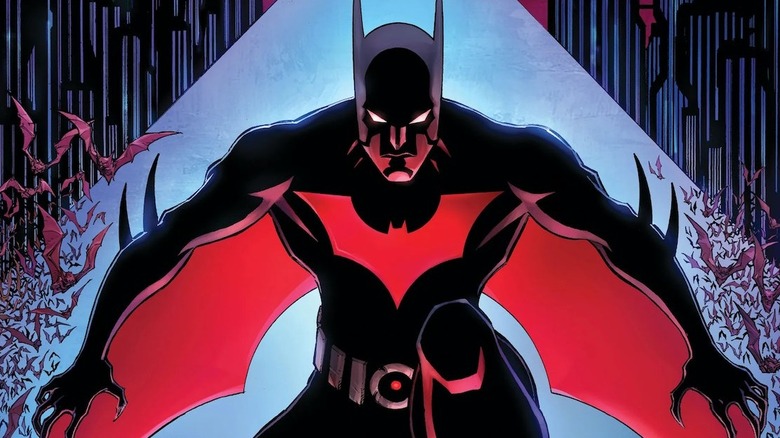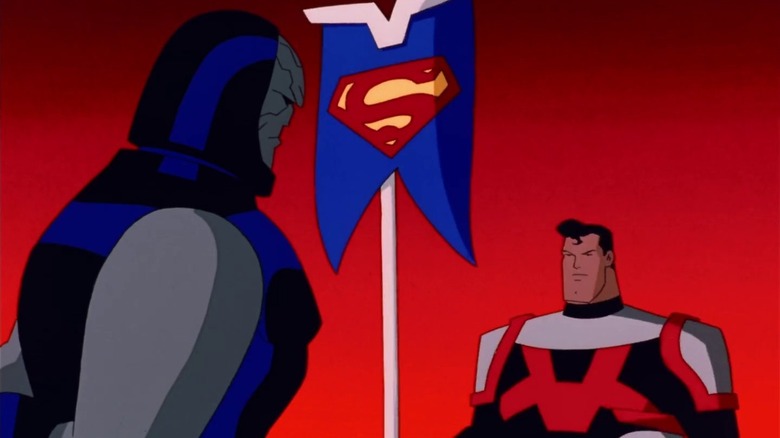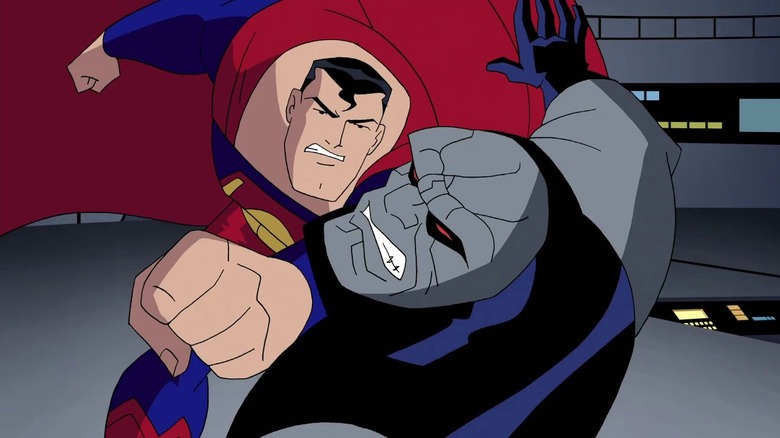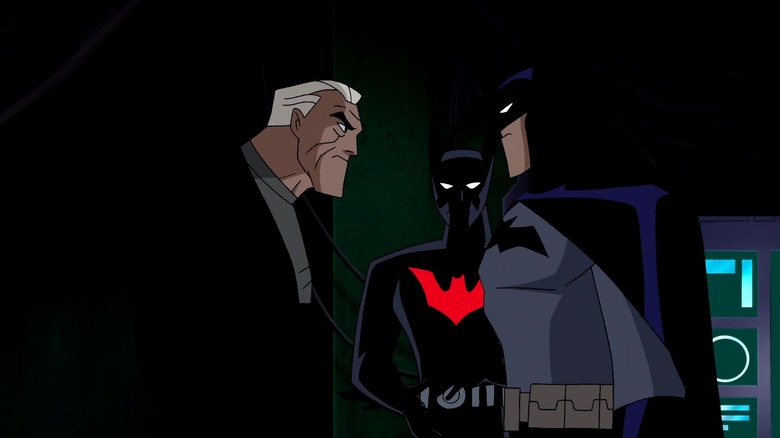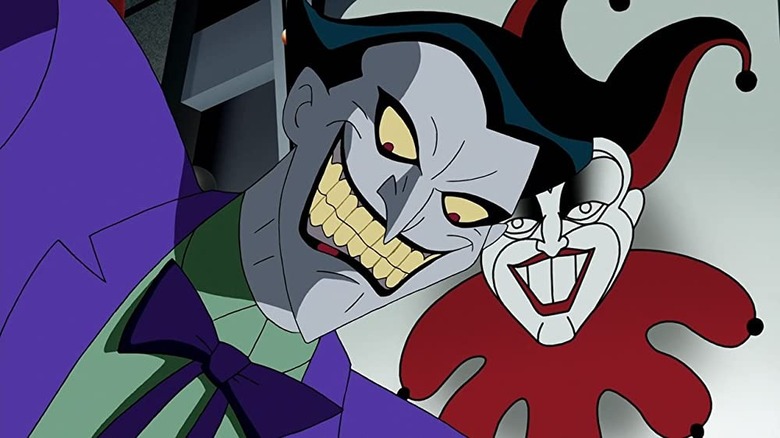Batman Beyond's Confusing Place In The Animated Series Timeline Explained
The superhero comic books of Marvel and DC use a static timeline, where no characters permanently age. That's what makes "Batman Beyond" so unique; following in the thematic footsteps of "The Dark Knight Returns," the show depicted a Bruce Wayne who'd aged out of the cowl. In his place, he trained teenage Terry McGinnis as the new Dark Knight. The film "Batman Beyond: Return of the Joker" even provided a definite end for "Batman: The Animated Series," showing via flashback the final battle between the original Batman and the Joker; the latter abducts Robin (Tim Drake) and tortures/brainwashes him into "Joker Junior." Tim ultimately snaps and kills the Joker with his own spear gun.
However, the next DC Animated Universe series, "Justice League"/"Justice League Unlimited," went back to the "present"/contemporary era. This left the creators constrained by what they established in "Batman Beyond" — or did it?
In an interview with Jim Harvey for DCAnimated.com during season 1 of "Justice League", DCAU godfather Bruce Timm explained how "Batman Beyond" was considered just a "possible future," both to free up storytelling on "Justice League" and placate fans who didn't like "Beyond" as the endgame for Batman. Timm invoked James Bond to explain himself:
"Continuity's a fluid thing. I mean, 'You Only Live Twice' completely invalidates/contradicts 'On Her Majesty's Secret Service,' but I like'em both, so they both happened! There, see how easy that was?"
However, this attitude didn't result in "Justice League" ignoring "Batman Beyond." Oftentimes, it was the opposite.
Keeping the DCAU newbie-friendly
"Batman Beyond" relies on viewer familiarity; the story resonates because of how it reinterprets the Batman myth. Timm, however, says that he and his fellow production staff tried to make "Justice League" into a gateway series: "We can't pre-suppose that everyone who watches "JL" has seen every episode of our previous series; more likely, most of them haven't."
For instance, "Superman: The Animated Series" ended with "Legacy," where the Man of Steel is brainwashed by Darkseid into invading Earth. At the end of the series, the public's trust in Superman is shattered ... but by the beginning of "Justice League," it's been rebuilt because a beloved Superman is what audiences would expect. Timm even cites a line that had to be rewritten to account for this.
"Originally, in part one of 'Secret Origins,' General Wells' line, 'We can't entrust the world's security to one man' ended with '... especially HIM!' We felt that anyone who hadn't seen 'Legacy' would be confused, wondering, 'Well, why NOT him? Why does this guy hate Superman so much?' As it is now, it works both ways: either Wells is just being a practical military tactician, or he doesn't trust the guy who almost conquered the world for Darkseid. Similarly, Superman's line, 'I've worked long and hard to earn your trust' has different meanings to long-time fans and 'newbie' audiences."
Whenever you try to please two competing groups of people, you'll eventually start to favor one. On "Justice League," the writers eventually came down on the side of longtime fans.
Turning to serialization
In the interview, Timm mentioned plans to bring in Darkseid to "Justice League," which would be fulfilled in the season 2 premiere, "Twilight." That episode is all about Superman's anger and uncharacteristic desire for revenge. Though the episode fills in new viewers on the backstory, its pathos relies on familiarity.
"Twilight" is the turning point when the "Justice League" decided to embrace serialization and the grand tapestry of the DCAU. This change in attitude carried over into "Justice League Unlimited." The first two seasons are driven by the events of "A Better World" from season 2 of "Justice League," wherein the Justice League of an alternate universe (the Justice Lords) went rogue and assassinated President Lex Luthor. So, the U.S. government created an organization called Cadmus, designed to create countermeasures against the Justice League. Meanwhile, the recently-pardoned Lex Luthor is running for President.
This storyline culminates in a twist seeded all the way back in "Ghost in the Machine," a previously standalone episode of "Superman: The Animated Series." Kryptonian AI Brainiac forces Luthor to build him a new body and then shoots him with a beam weapon; Luthor mysteriously walks away unharmed. It's revealed in "Justice League Unlimited" season 2 finale — "Divided We Fall" — that beam actually seeded a copy of Brainiac's programming inside Luthor, which has been manipulating events since. Few retcons are as elegant as this one.
Embracing Batman Beyond
In the aforementioned interview, Timm downplayed possible links between "Justice League" and "Batman Beyond" — "I guess sub-consciously I WAS thinking about a link from 'B:TAS' to 'JL' to 'Beyond' when I gave Batman his new big-ass ears and heeled boots, but I wouldn't swear to it..."
However, "Justice League Unlimited" soon embraced "Batman Beyond." The season 1 finale — "The Once and Future Thing" — features Batman, Green Lantern, and Wonder Woman sent to an alternate future where time-traveling villain Chronos rules. A small resistance is led by Terry McGinnis and the elderly Bruce Wayne, while the Jokerz gang from "Return of the Joker" are Chronos' enforcers. However, this episode actually reaffirms Timm's argument about fluid canon. Though it acknowledges "Batman Beyond," the point of the episode is how the future can change. If this version of "Batman Beyond" is just an alternate future, who's to say the timeline from the series itself isn't one as well?
The season 2 finale of "Justice League Unlimited" — "Epilogue" — is less ambiguous. The episode features a now adult Terry visiting the elderly Amanda Waller and learning the role she played in shaping his life. "Epilogue" weaves together threads from across the DCAU to give "Batman Beyond" the series finale it never had during its original run.
To absent friends
"Batman Beyond" was relatively easy for "Justice League" to ignore — it was set forty-ish years in the future. The flashback sequence in "Return of the Joker" was trickier though, since it was set in the present and featured a Robin who didn't look any older than he had in "The New Batman Adventures."
The Joker (voiced as always by Mark Hamill) showed up twice on "Justice League," first as a member of the Injustice Gang in "Injustice for All" in season 1 and then as the main villain of "Wild Cards" in season 2. That would seem to set "Justice League" before the flashback sequence in "Return of the Joker," though Timm was more laissez-faire (via DCAnimated.com): "Ultimately, though, since we want to use Joker in 'JL,' obviously Robin can't have killed him yet...or maybe he never WILL...ow, my head hurts..."
Eventually, the issue was solved for the "Justice League." Due to the concurrent "The Batman" cartoon, "Teen Titans" which starred Robin, and "Batman Begins," Batman's sidekicks and villains were declared off-limits during "Justice League Unlimited." This became known as the "Bat-Embargo."
"Justice League Unlimited" also became the final series in the DCAU. Thus, if fans want one single narrative, it becomes relatively easy to reconcile the "Return of the Joker" flashback with "Justice League." Either it's the in-universe reason why Robin, Batgirl, and the Joker never show up in "Unlimited," or it just happens after the series is over. The latter would certainly explain why all the character development that Bruce undergoes in "Justice League," learning to be more open and a team player, is undone by "Batman Beyond."
